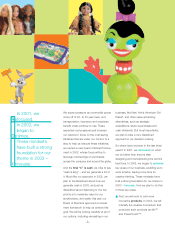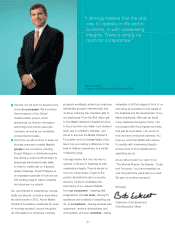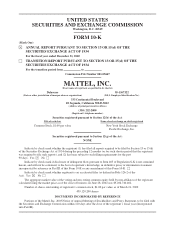Mattel 2002 Annual Report Download - page 14
Download and view the complete annual report
Please find page 14 of the 2002 Mattel annual report below. You can navigate through the pages in the report by either clicking on the pages listed below, or by using the keyword search tool below to find specific information within the annual report.
Revenues from Mattel’s International segment represented approximately 36% of total consolidated gross
sales in 2002. Within the International segment, Mattel operates in four regions that generated the following
gross sales during 2002 (in millions):
For the Year
2002
Amount Percentage
Europe .......................................... $1,126.1 60%
Latin America ..................................... 461.7 24
Canada .......................................... 171.4 9
Asia Pacific ...................................... 138.2 7
$1,897.4 100%
No individual country within the International segment exceeded 6% of consolidated gross sales during
2002.
The strength of the US dollar relative to other currencies can significantly affect the revenues and
profitability of Mattel’s international operations. Mattel enters into foreign currency forward exchange and
option contracts primarily to hedge its purchase and sale of inventory and other intercompany transactions
denominated in foreign currencies to limit the effect of exchange rate fluctuations on its results of operations and
cash flows. See Item 7A “Quantitative and Qualitative Disclosures About Market Risk” and Item 8 “Financial
Statements and Supplementary Data—Note 8 to the Consolidated Financial Statements.” For financial
information by geographic area, see Item 8 “Financial Statements and Supplementary Data—Note 11 to the
Consolidated Financial Statements.”
Manufacturing
Mattel manufactures toy products for all segments in both company-owned facilities and through
independent contractors. Products are also purchased from unrelated entities that design, develop and
manufacture the products. To provide greater flexibility in the manufacture and delivery of products, and as part
of a continuing effort to reduce manufacturing costs, Mattel has concentrated production of most of its core
products in Mattel’s facilities and generally uses independent contractors for the production of non-core
products.
Mattel’s principal manufacturing facilities are located in China, Indonesia, Malaysia, Mexico and Thailand.
Mattel also utilizes independent contractors to manufacture products in the US, Europe, Mexico, the Far East and
Australia. To help avoid disruption of its product supply due to political instability, civil unrest, economic
instability, changes in government policies and other risks, Mattel produces many of its key products in more
than one facility. In 2001, Mattel announced plans to close distribution and manufacturing facilities in Murray,
Kentucky, which were closed in 2002. In January 2003, Mattel announced the consolidation of two of its
manufacturing facilities in Mexico as part of the financial realignment plan. See Item 7 “Management’s
Discussion and Analysis of Financial Condition and Results of Operations—Financial Realignment Plan” and
Item 8 “Financial Statements and Supplementary Data—Note 10 to the Consolidated Financial Statements.”
Mattel believes that its existing production capacity at its own and its independent contractors’ manufacturing
facilities are sufficient to handle expected volume in the foreseeable future. See Item 7 “Management’s
Discussion and Analysis of Financial Condition and Results of Operations—Factors That May Affect Future
Results.”
Mattel bases its production schedules for toy products on customer orders, taking into account historical
trends, results of market research and current market information. Actual shipments of products ordered and
order cancellation rates are affected by consumer acceptance of product lines, strength of competing products,
5
























